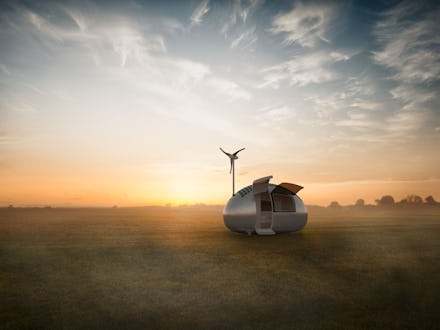This Tiny Wind-Powered House for Two Is All You Need to Live

How much do you really need to live? What are the objects without which your quality of life would diminish? How much, through the course of your daily routine — the tools, the well-worn outfits, the rooms you laze around in — would you need, and how much is clutter that you could clear away if you had to?
Miniature houses like the Ecocapsule, whose living space is just 8 square meters, or 86 square feet, challenge you to evaluate just that in order to minimize your life. A team of Slovak designers built the Ecocapsule to be the perfect little luxury home for travel, adventuring, research or just off-the-grid living.
It has a desk, a place to sit, a bed in the main living space, a kitchenette, a few windows, a bathroom with a shower, and even a little storage trunk. The capsule takes care of its own energy. The small antenna is a wind turbine, the top of the capsule is covered with solar panels and the capsule collects rain to provide itself with fresh water.
Its features list may be spare, but what little Ecocapsule has is high quality and luxurious. This is Igor Zacek, one of the designers, sitting in the main area:
One of the advantages of the Ecocapsule is that it can go anywhere: freakishly small plots of lands, remote destinations and the excess corners of crowded urban landscapes. They're portable and can be towed, hitched to a trailer, put in a shipping container, pulled by a few horses, dragged out onto beaches and lifted onto roofs and cliffsides.
There's no definite price yet this year — similar miniature houses go from just a few thousand USD to as much as $50,000 to $80,000 — but the Ecocapsule already has high-profile fans ready for preorders:
There's a growing movement around tiny houses. There are tiny houses designed for travel, environmental sustainability, disaster relief, urban living, artist retreats — any application or cause where less is more, where freedom and flexibility are better than being a part of a neighborhood, and where scenery takes priority over permanence.
Tiny houses are also a way to build an extra home on land where you already have a house. In the space you'd use to build a small children's play area, you can set up a small home to keep guests or an obnoxiously independent teenager. In Minnesota, cheap pre-fabs in the backyard are the budding alternative to sending grandparents off to assisted living, an option that allows someone to keep an elder family member close at hand without having to share a bathroom and hallway.
And, if you can handle it, they're better for the environment. Whether it's the small wooden prefabs from Tumbleweed Tiny House Company or the self-sustaining, food growing "Earthships" made of tires and bottles that litter the New Mexico landscape, tiny houses are built with energy efficiency and the environment in mind. They force you to accumulate less, pile on fewer belongings and subsequently produce less detritus.
But maybe the best argument for casting away the shackles of clutter and excess in favor of an elf-sized home on wheels isn't ecological, but economic. The debate rages on over whether millennials do or don't want to buy houses of their own, and if there's anything to sweeten the deal for deed-shy 20-somethings, it's affordability.
So think of your wallet, think of the space you use, the things you need, the environment, the economy, travel, independence. Now: How much do you really need to live?